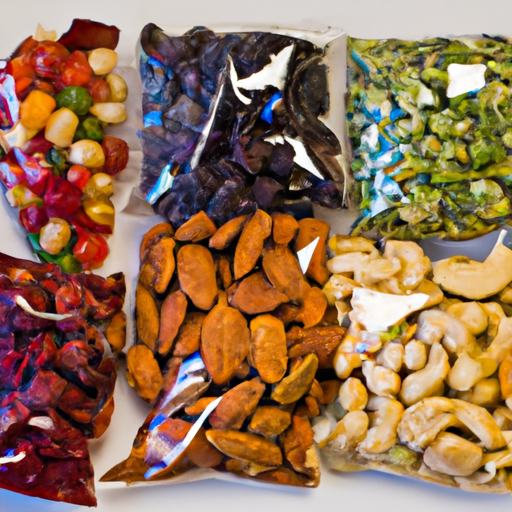How To Pack Food For Backpacking
Planning a backpacking trip can be exciting, but figuring out how to pack food efficiently and safely can sometimes be a daunting task. In this article, you will discover some essential tips and tricks on how to pack food for backpacking, ensuring that you have delicious and nourishing meals to sustain you throughout your adventure. From choosing lightweight and non-perishable items to using proper storage techniques, these practical suggestions will help you pack smartly, allowing you to focus on enjoying your time in nature without worrying about your next meal.
Choosing the Right Food
When it comes to choosing the right food for your backpacking adventure, there are a few key factors to consider. One of the most important things to take into account is your nutritional needs. Backpacking can be physically demanding, so it’s essential to fuel your body with the right foods. Opt for lightweight and compact options that won’t weigh you down and take up too much space in your pack. Additionally, packing high-energy foods will give you the stamina you need to keep going. Finally, make sure to include a balanced mix of macronutrients, such as carbohydrates, proteins, and fats, to provide your body with the necessary fuel and nutrients.
Meal Planning
Proper meal planning is crucial for a successful backpacking trip. Start by determining the number of meals you’ll need to pack for. Consider how many days you’ll be out and how many meals you’ll be eating each day. Planning for variety in your meals is also essential. Eating the same thing every day can quickly become monotonous, so mix it up by including different types of food and flavors. Additionally, take into account the cooking methods you’ll have available. Will you be able to cook over open flames, or will you need to rely on a camp stove? Finally, account for any special dietary needs or restrictions you or your fellow backpackers may have, such as vegetarian or gluten-free options.
Prepping and Packaging
Preparing and packaging your food properly is key to making sure it stays fresh and lightweight during your backpacking trip. One method to achieve lighter weight is to dehydrate your foods. Dehydrating removes the water content from food, significantly reducing its weight. This is especially useful for fruits, vegetables, and even cooked meals like chili or pasta. Another packaging option is to use freezer bags or Ziplock bags. These are lightweight and will keep your food secure and protected. If you prefer more durable containers, invest in lightweight options specifically designed for backpacking. Remember to label and organize your meals to make it easier to locate and track your food throughout your trip.
Smart Packing Techniques
Smart packing techniques can help you maximize space and keep your food organized during your backpacking adventure. One useful technique is to pack food in individual meal packets. This way, you can grab one packet per meal, making it easy to track your food consumption. It also helps with portion control. Another tip is to utilize empty spaces in your pack. You can fill in gaps with smaller food items or by placing them in the pockets of your backpack. When packing fragile items like eggs or delicate fruits, make sure to wrap them securely to prevent any damage. Lastly, place heavier items closer to your back, distributing the weight evenly and maintaining balance while hiking.
Storing and Cooling
Storing your food properly is crucial, especially when it comes to non-perishable items. Items like granola bars, nuts, and dried fruits can be stored in airtight containers to keep them fresh and protected from moisture. For perishable foods, it’s essential to keep them cool to prevent spoilage. Utilize natural cooling methods by placing perishable items in a cool, shaded area or a flowing stream if available. Consider using insulated cooler bags or even freezing some items beforehand if extended cooling is required.
Handling Waste
When embarking on a backpacking trip, it’s important to follow Leave No Trace principles to minimize our impact on the environment. This includes packing out what you pack in, meaning any waste or leftover food should be brought back with you and disposed of responsibly. It’s crucial to leave nature as untouched as possible and avoid leaving any waste behind. Make sure to bring along suitable waste bags or containers to store your trash until you can properly dispose of it.
Considerations for Longer Trips
For longer backpacking trips, a few additional considerations come into play. One of them is meal resupply options. Depending on the duration and location of your trip, you may have the opportunity to resupply food along the way. Research the availability of grocery stores or local markets on your route to plan for potential resupply points. Dividing and conquering the packing can also be beneficial. If traveling with a group, distribute the weight of food among the members to make it more manageable. Lastly, be mindful of packaging waste. Consider repackaging bulk items into smaller portions to reduce the amount of packaging you’ll need to carry.
Safety and Food Hygiene
Maintaining proper food temperature is essential for food safety during backpacking trips. When storing perishable items, make sure they stay within a safe temperature range to prevent bacterial growth that could lead to foodborne illnesses. Use insulated containers or coolers with ice packs to keep your food at a safe temperature. It’s also crucial to avoid cross-contamination. Keep raw meats separate from other foods to prevent the spread of bacteria. Finally, be cautious when sourcing water for cooking and drinking. Use either treated water or boil water from natural sources to ensure it is safe to consume.
Additional Tips and Tricks
Here are some additional tips and tricks to make your backpacking food experience even better. Practice packing and cooking beforehand to familiarize yourself with the process and make any necessary adjustments. Don’t forget to bring essential cooking utensils like a stove, pot, and utensils to ensure you can properly prepare your meals. Carry emergency snacks like energy bars or trail mixes in case you need an extra boost of energy on the trail. Lastly, pack spices and flavor enhancers to add variety and enhance the taste of your meals.
Conclusion
Packing food for backpacking doesn’t have to be complicated. By considering your nutritional needs, planning your meals, prepping and packaging wisely, utilizing smart packing techniques, and prioritizing safety and food hygiene, you can enjoy delicious and nourishing meals while exploring the great outdoors. Remember to be mindful of waste, follow Leave No Trace principles, and make smart choices for longer trips. With these tips and tricks, you’ll be ready to embark on an unforgettable backpacking adventure with a well-packed and tasty menu. Happy backpacking!




